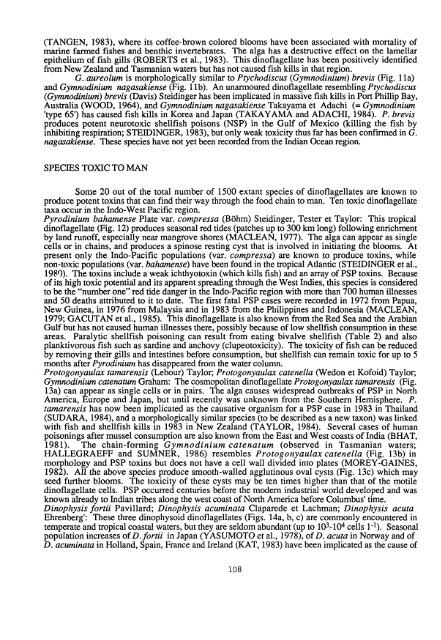139736eo.pdf (20MB) - Japan Oceanographic Data Center
139736eo.pdf (20MB) - Japan Oceanographic Data Center
139736eo.pdf (20MB) - Japan Oceanographic Data Center
- No tags were found...
You also want an ePaper? Increase the reach of your titles
YUMPU automatically turns print PDFs into web optimized ePapers that Google loves.
(TANGEN, 1983), where its coffee-brown colored blooms have been associated with mortality ofmarine farmed fishes and benthic invertebrates. The alga has a destructive effect on the lamellarepithelium of fish gills (ROBERTS et al., 1983). This dinoflagellate has been positively identifiedfrom New Zealand and Tasmanian waters but has not caused fish kills in that region.G. aureolum is morphologically similar to Ptychodiscus (Gymnodinium) brevis (Fig. 1 la)and Gymnodinium nagasakiense (Fig. 1 1 b). An unarmoured dinoflagellate resembling Ptychodiscus(Gymnodinium) brevis (Davis) Steidinger has been implicated in massive fish kills in Port Phillip Bay,Australia (WOOD, 1964), and Gymnodinium nagasakiense Takayama et Adachi (= Gymnodinium‘type 65’) has caused fish kills in Korea and <strong>Japan</strong> (TAKAYAMA and ADACHI, 1984). P. brevisproduces potent neurotoxic shellfish poisons (NSP) in the Gulf of Mexico (killing the fish byinhibiting respiration; STEIDINGER, 1983), but only weak toxicity thus far has been confirmed in G.nagasakiense. These species have not yet been recorded from the Indian Ocean region.SPECIES TOXIC TO MANSome 20 out of the total number of 1500 extant species of dinoflagellates are known toproduce potent toxins that can find their way through the food chain to man. Ten toxic dinoflagellatetaxa occur in the Indo-West Pacific region.Pyrodinium bahamense Plate var. compressa (Bohm) S teidinger, Tester et Taylor: This tropicaldinoflagellate (Fig. 12) produces seasonal red tides (patches up to 300 km long) following enrichmentby land runoff, especially near mangrove shores (MACLEAN, 1977). The alga can appear as singlecells or in chains, and produces a spinose resting cyst that is involved in initiating the blooms. Atpresent only the Indo-Pacific populations (var. compressa) are known to produce toxins, whilenon-toxic populations (var. bahamense) have been found in the tropical Atlantic (STEIDINGER et al.,1989). The toxins include a weak ichthyotoxin (which kills fish) and an array of PSP toxins. Becauseof its high toxic potential and its apparent spreading through the West Indies, this species is consideredto be the “number one” red tide danger in the Indo-Pacific region with more than 700 human illnessesand 50 deaths attributed to it to date. The first fatal PSP cases were recorded in 1972 from Papua,New Guinea, in 1976 from Malaysia and in 1983 from the Philippines and Indonesia (MACLEAN,1979; GACUTAN et al., 1985). This dinoflagellate is also known from the Red Sea and the ArabianGulf but has not caused human illnesses there, possibly because of low shellfish consumption in theseareas. Paralytic shellfish poisoning can result from eating bivalve shellfish (Table 2) and alsoplanktivorous fish such as sardine and anchovy (clupeotoxicity). The toxicity of fish can be reducedby removing their gills and intestines before consumption, but shellfish can remain toxic for up to 5months after Pyrodinium has disappeared from the water column.Protogonyaulax tamarensis (Lebour) Taylor; Protogonyaulax catenella (Wedon et Kofoid) Taylor;Gymnodinium catenanun Graham: The cosmopolitan dinoflagellate Protogonyaulax tamarensis (Fig.13a) can appear as single cells or in pairs. The alga causes widespread outbreaks of PSP in NorthAmerica, Europe and <strong>Japan</strong>, but until recently was unknown from the Southern Hemisphere. P.famarensis has now been implicated as the causative organism for a PSP case in 1983 in Thailand(SUDARA, 1984), and a morphologically similar species (to be described as a new taxon) was linkedwith fish and shellfish kills in 1983 in New Zealand (TAYLOR, 1984). Several cases of humanpoisonings after mussel consumption are also known from the East and West coasts of India (BHAT,1981). The chain-forming Gymnodinium catenatum (observed in Tasmanian waters;HALLEGRAEFF and SUMNER, 1986) resembles Protogonyaulax catenella (Fig. 13b) inmorphology and PSP toxins but does not have a cell wall divided into plates (MOREY-GAINES,1982). All the above species produce smooth-walled agglutinous oval cysts (Fig. 13c) which mayseed further blooms. The toxicity of these cysts may be ten times higher than that of the motiledinoflagellate cells. PSP occurred centuries before the modern industrial world developed and wasknown already to Indian tribes along the west coast of North America before Columbus’ time.Dinophysis fortii Pavillard; Dinophysis acuminata Claparede et Lachman; Dinophysis acutaEhrenberg’: These three dinophysoid dinoflagellates (Figs. 14a, b, c) are commonly encountered intemperate and tropical coastal waters, but they are seldom abundant (up to 103-104 cells I-’). Seasonalpopulation increases of D. fortii in <strong>Japan</strong> (YASUMOTO et al., 1978), of D. acuta in Norway and ofD. acuminata in Holland, Spain, France and Ireland (KAT, 1983) have been implicated as the cause of108
















